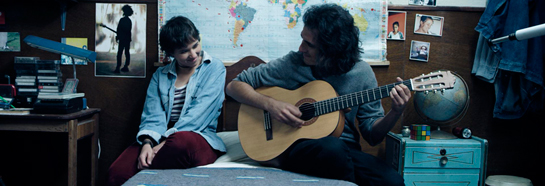Tombuktu Films |
LONG-FEATURE FILM TRIP TO TIMBUKTUDirector’s intention noteTrip to Timbuktu is a story of love and friendship in a time of violence, injustice and war. It´s also a story of trip and emigration. It´s a search of better places in which to be and live. It´s the story of many young people who were teenagers in Peru in the 80´s, a decade remembered for the blackouts, the attacks of the “Shining Path”, the dead and disappeared victims of the terrorism and the Army, the economical crisis, the general feeling of discourage, and the escape of a great number of people as a result of not being able to stand instability and fear anymore. Trip to Timbuktu is the “learning” trip of a group of teenagers, the one that makes them grow and mature, which makes them lose the innocence; the trip that supposes understanding the country where they are living, that journey to the Andes which confronts them with what was really happening in the country; the emigration trip they finally make, when they see their dreams flying away; and the imagination trip, the one that lets them escape from reality. Timbuktu is present since the moment they start counting ships in the beach of their childhood, and keeps as a destiny until they are teenagers, as a secret code only both of them share. Ana even calls Timbuktu to the place she´s going to emigrate, although we know she´s really going to Europe. Timbuktu is the only place where perhaps it´s possible to be happy. Ana and Lucho are the principal characters, two kids of an impoverished middle-class of Lima who fall in love in the 80´s, but who will see their love being failed because of the situation of violence they go through. I think the way of telling a story depends on the heart of that story. In this case, the heart is in this couple and especially in Ana. Trip to Timbuktu is a dramatic film which touches themes which are anchored in reality, deep and painful human experiences, and which shows sensitive characters, with a creative inner world, which makes the film poetic and intimate, besides its hardness. This makes me think in two lines when shooting the film: one, of a realistic and naturalist style, which will avoid a stereotyped world and characters; and a second one, more poetic, more anchored in dream, imagination and illusion. I have thought in saturated colors and the presence of natural sunlight during the times of childhood, when illusion was possible; on the other hand, during the dark times of teenage life, when the country was falling into pieces, I have thought in a “washed” and dirty image, very similar to many films of the 80’s, especially British ones, with a punk and urban spirit. I can see a camera in hand, instability and scenes where there is always a “red” element, to remind the “wound” of the characters, such as Wim Wenders did with Robby Müller, his director of photography, in Paris, Texas. An important point in how to focus this film is that although we´re telling a story in a time of violence, this violence will always be suggested in a subtle way, as a subtext, as for example, through Ana´s drawings and “films” in Super-8. Violence is never explicit. Thus, this is not a violent or warlike film. The principal actors will be children and teenagers, non-professional actors who are being chosen through a careful casting process. On the other hand, the parents and grandparents will be professional actors. Considering the presence of children, my reference will always be the direction work of François Truffaut; in more present times, the work of directors such as Abdellatif Kechiche, Nicolas Philibert and Jacques Doillon will also be a source of inspiration. Another important point to mention is the music: it is a story which shows the lives of a group of teenagers of the 80’s who love music. Thus, this will be the first Peruvian film with soundtrack of rock of the 80’s. The music has a dramatic importance in the story, it’s not decorative, and the work of direction is closely related to its presence. I was also a teenager of the 80´s in Peru. The story of these teenagers is also mine and of all those who came along with me in my trip of growth and discovery of the world, in Lima, the city where I was born. This has been my principal motivation when writing this story: not only to remember what happened to us when we were young, what happened to our families and country, but also, to let the world know about it. To remember the time of violence in our country and its terrible consequences, can lead us to meditation on our reality and can avoid them in the future. Our country has a fragile historical memory, and films like this can help us to preserve the memory and reach reconciliation. But, I also want to show that in the middle of war and death, it´s possible to feel love, illusion and tenderness. And finally, I must say I was also one of those youngsters who had to leave the country in search of better places in which to be and live, as so many others, who couldn´t face the time they had to live in their country. Showing the phenomenon of emigration as a result of poverty, war and injustice, can take us to a second meditation: why is it necessary to look for the dream outside, while Timbuktu should be in our own country. All human beings should have the right and the possibility of creating the dream in the place where they were born. Rossana Díaz Costa |
||||
| Inicio | Rossana Diaz Costa | Largometraje Viaje a Tombuctú | Largometraje Un Mundo para Julius | Links de Interés | Contacto |
